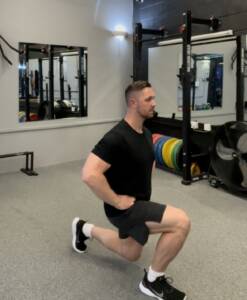
Walking lunges function as an excellent exercise to target all the major muscle groups of your lower body while simultaneously improving your balance and core strength. This movement is familiar to most people—it involves taking wide forward steps, bending both knees, and lowering your back knee to the floor while keeping your torso upright and tall.
Unlike stationary lunges, walking lunges present an added challenge—you have to maintain your balance while stepping forward between each lunge, shifting your weight and body position while temporarily standing on one leg. Considering how vital balance and stability are for functional fitness, this added challenge is beneficial for preventing falls and fall-related injuries.
How to Do Walking Lunges
As a bodyweight exercise, you need very little to get started with walking lunges. The more room you have, the more lunges you will be able to take without turning around. Most importantly, you need an open space to take at least wide strides in succession. Parks, gymnasiums, and open hallways are excellent options, but even an available living room will suffice.
Stand with your feet roughly hip-distance apart.
Check your posture before starting—your torso should be upright and tall, core engaged, your shoulders back and chin lifted and look straight ahead.
Take a wide step forward with your right foot—plant it roughly two feet ahead, allowing your left heel to lift naturally as you step forward. You may want to put your hands on your hips, or you may want to swing your arms naturally—elbows bent at 90-degrees as you take each step.
Keep your core engaged and upright.
Bend both knees and lower your back knee toward the floor. Stop just before it touches down. Breathe in during the lowering (or eccentric) phase of the exercise.
Press firmly through your right heel and extend your right knee to rise to stand as you lift your left foot from the ground, swinging your left foot forward to plant it about two feet ahead of your right foot. Avoid leaning your torso forward from your hips as you take this step. Breathe out as you rise to stand (the concentric phase of the exercise).
Continue stepping forward with each lunge, alternating sides as you do. If you find yourself losing balance as you walk, pause at the top of each lunge when your feet are next to each other. Gather your balance, then continue.
Finish your set by bringing your back foot to meet your front foot on the final lunge.
Common Mistakes
Compound exercises that use multiple muscle groups often come with pitfalls and common mistakes—mainly because there are so many joints involved. It’s easy to slack off on form or not notice where you’re getting something wrong.
Lunges are one of the biggest culprits, and form tends to suffer most as you get tired. Take your time and pay attention. If you can, perform the exercise in front of a mirror until you feel comfortable with it so you can catch mistakes as they happen. Here are some mistakes to watch out for.
Putting Feet Too Close Together While Stepping
Pay attention to your foot placement as you take each forward step. You want your feet to remain roughly hip-distance apart (or slightly wider) to offer a good base of support for balance and stability.
If your feet are too close together, where the heel of your forward foot is aligned with the toes of your back foot, you’re much more likely to lose your balance. As you walk forward, your stride width should feel natural—as though you were simply taking longer strides with your normal gait.
Taking Steps That Are Too Long
Another common mistake is overstriding. Yes, during lunges, your steps should be longer than usual, but they shouldn’t be so long that you create an uncomfortable stretch through your groin as you lower your back knee to the floor.
Rather, take long steps, but plant your front foot just about two or two-and-a-half feet in front of your back foot. When you perform the lunge, both knees should be able to form roughly 90-degree angles at the bottom of the movement.
Leaning Forward From the Hips
During walking lunges, you’re constantly moving forward, and there’s a strong tendency for your torso to start leaning forward to “help” you shift as you lunge. This typically happens when you’re trying to speed through a set and you use the momentum of a forward lean to help you drive into each lunge. It also happens frequently if you’re overstriding—taking longer steps than necessary for each lunge.
The problem is that you disengage your core and could end up hurting your low back if you’re not careful. Slow down and pay close attention to your chest as you walk—it shouldn’t start leaning toward the ground.
Keep your abdominals and core muscles engaged and try to keep your torso roughly perpendicular to the floor throughout each lunge. Looking forward, with your eyes on the wall in front of you, can also help.
